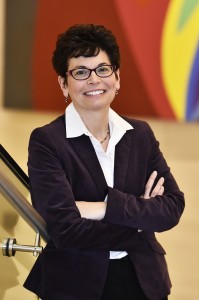
April 10, 2015
Five years ago, Fordham College at Lincoln Center student Ben Guhin was looking to dissolve the boundaries between computer science and visual arts majors. His adviser found a way for him to craft his own individual major.
But his efforts caught the attention of faculty and administrators: If the commercial world merges the subjects, why not the academy?
Guhin’s timing couldn’t have been better. The University was in the midst of building a new law school and undergraduate residences, designed to expand Fordham’s student body and to woo applicants with new majors. And there was already talk about upgrading the media facilities.
“We were starting to realize that students knew more than we did when it came to new media,” said Robert Grimes, SJ, dean of Fordham College at Lincoln Center (FCLC).
What evolved was Fordham’s New Media and Digital Design program. The program and its new major are a joint effort between five academic entities: the Communication and Media Studies Department coordinates with the departments of Computer and Information Science, Theatre and Visual Arts, and English; and with the Gabelli School of Business. It offers three tracks: commerce, information, and text and design. Students from all four of Fordham’s undergraduate colleges can enroll.
To get the ball rolling on new programs and majors Father Grimes convened a general faculty meeting and asked participants not to sit with colleagues from their departments. A brainstorming session ensued and proposals for eight different programs emerged. Faculty fine-tuned the proposals and presented them in September 2012 to a committee. By January 2013 they put them forward for a vote. Of the eight proposals, one was dropped and one was downgraded to a minor. The rest were sent to new working groups to be developed into specific proposals.
The New Media and Digital Design program garnered mostly positive comments throughout the process. Heard were: “It bridges the gap between technical knowhow and creativity,” and “Its strong liberal arts and sound social theory makes it unique, rather than just job training.” There was some pushback that English courses be part of the curriculum—which eventually did happen.
Amy Aronson, PhD, the program’s present director, was part of the working group that developed the specific proposal. She said the nature of the new media landscape lends itself to collaboration among the departments. But, she added, one of the challenges was building coherence.
“The question was how do you connect the dots between the subjects, and how do you envision gaps before they occur,” she said.
There was plenty of synergy in the group, as well as a healthy dose of friction.
“The idea of the public sphere is this open space that anyone can participate in, and where multiple discourses are out there that collide and collaborate with each other,” she said.
She acknowledged concerns, indeed fears, in which multidisciplinary approaches might water down highly specialized fields. For example, would a non-computer science major contribute as much to a course as a full-time computer science major?
“There’s always a trade-off in interdisciplinary environments, but new media is a different kind of knowledge that yields different kinds of insights,” she said.
Aronson said the committee had a “remarkably easy time” getting the program through Fordham’s council structure as well as getting New York State approval.
“There was quite a bit of shared knowledge among faculty who have been here before and know what’s expected,” she said.
Both Father Grimes and Aronson agree that the biggest challenge, not surprisingly, was funding. Upgrading the software alone cost $25,000. Next up will be the hardware—to say nothing of renovating physical spaces.
“When you’re in the middle of Manhattan, space is at a premium,” said Father Grimes. “We’ve become masters of space. All you have to do is look at our faculty offices, which would be broom closets on any other campus.”
with new space at the Lincoln Centers campus’ old law school set to open in 2016, Father Grimes said that FCLC would get some breathing room, but with that comes the added expense of renovations. As such, he said, the efficiency of cross-disciplinary programs makes economic sense.
“We we’re looking at is an expensive major, so we shouldn’t be reduplicating our efforts,” he said. “We make the full use of all classes and both campuses.”
Fordham’s Rose Hill campus in the Bronx, established in 1841, is the gothic counterweight to Lincoln Center’s Manhattan modernism. “Ram Vans” run between the two campuses every half hour.
“We may have two campuses but we’re not that far apart,” he said.
The new media program launched last fall. It is already the twelfth largest major in Fordham College at Lincoln Center. Aronson regularly touches base with her students to gauge the program’s progress. For colleagues considering forming a new program, she has sage advice.
“Be prepared to keep records of everything in the beginning because you won’t know what you’ll need later,” she said. “Keep spreadsheets and Google docs. And try to involve and rely on your executive committee. It helps the program tremendously if you can tap into their talents.”
Once the program is up and running there’s still a five-year development period, said Aronson. She monitors student progress in both formal and informal settings, and uses Survey Monkey for feedback. She’s still developing outreach mechanisms to touch base at “key pivot points in the year.”
“It’s very demanding work, but if you focus on all the things you learn, that’s very satisfying,” she said. “It keeps me energized.”
###
